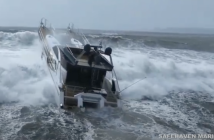Few things are more terrifying on the water than a nearby lightning strike; the sound and the fury of the explosive electrical discharge will stir fear in the heart of the most crusty mariner. Now, with boating season getting underway, here’s some timely advice from the US Power Squadrons/America’s Boating Club about how to protect yourself if you do get caught out in a lightning storm:
Most lightning strikes occur in the afternoon with 70% occurring between noon and 6 p.m. As the air temperature warms, evaporation increases. This warm, moisture-laden air rises and evaporates, forming fluffy cumulus clouds. As more moisture accumulates, the clouds darken and change into cumulonimbus, or thunderstorm, clouds.
Well-developed cumulonimbus clouds have a flat anvil-shaped top and can reach 40,000 feet or more. The cloud’s upper portion develops a positive electrical charge and the lower level a negative electrical charge. Lightning occurs when the difference between the positive and negative charges—the electrical potential—becomes great enough to overcome the resistance of the insulating air and force a conductive path between the positive and negative charges. This potential may be as much as 100 million volts.
Lightning strikes represent a flow of current from negative to positive (in most cases) and may move from the bottom to the top of a cloud, from cloud to cloud, or (most feared) from cloud to ground. When lightning does strike, it most often strikes the highest object in the immediate area. On a body of water, that highest object is a boat.
When caught in a storm
- Stay in the center of the cabin if the boat has one. If it has no cabin, stay low in the boat. Don’t be a human lightning mast!
- Keep arms and legs in the boat. Do not dangle them in the water.
- Discontinue fishing, water skiing, scuba diving, swimming or other water activities when lightning is present or weather conditions look threatening. The first lightning strike can be a mile or more in front of an approaching thunderstorm cloud.
- Disconnect and do not touch the major electronic equipment, including the radio, for the duration of the storm. Lower, remove or tie down the radio antenna and other protruding devices if they aren’t part of the lightning protection system. Read more: http://www.theensign.org/uspscompass/callout2.html?fbclid=IwAR3RrhPW8B0DWx6hr8QdQNoNGp07kwUBDWE00PgH3Dn80GZkga_1Gs7bvD8




